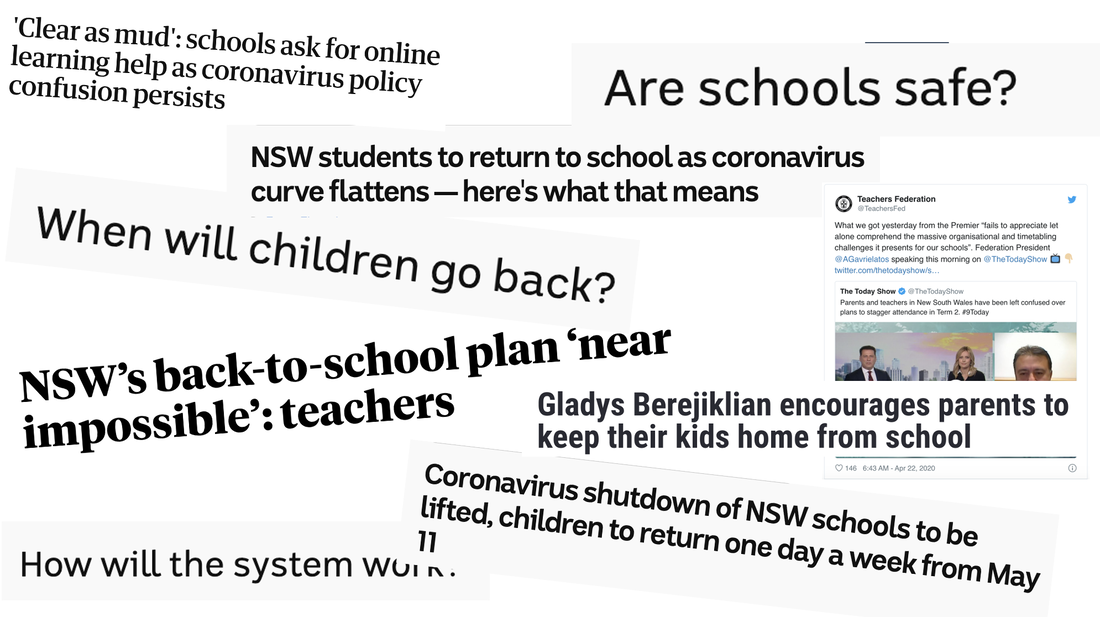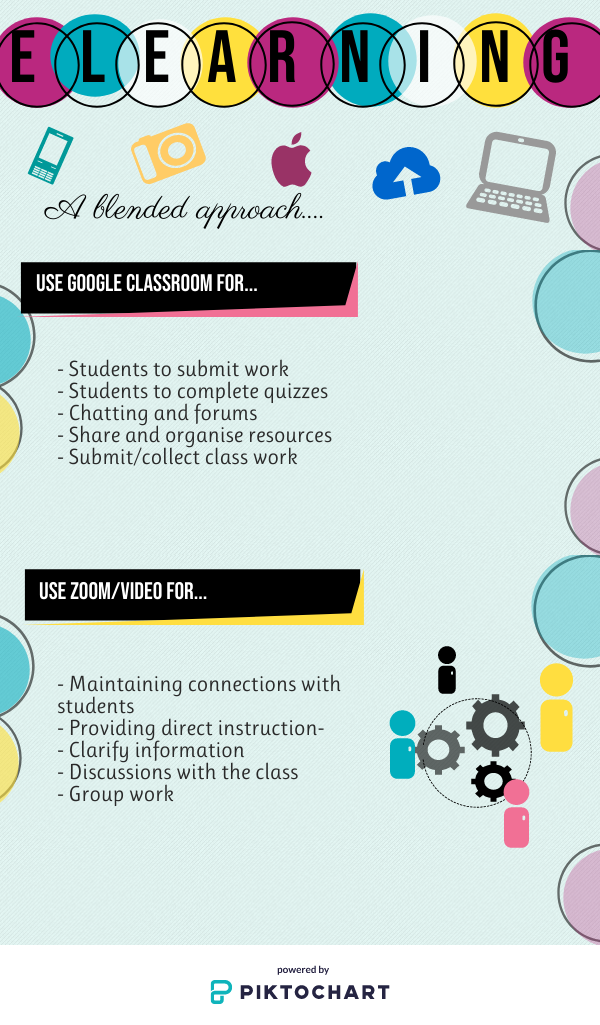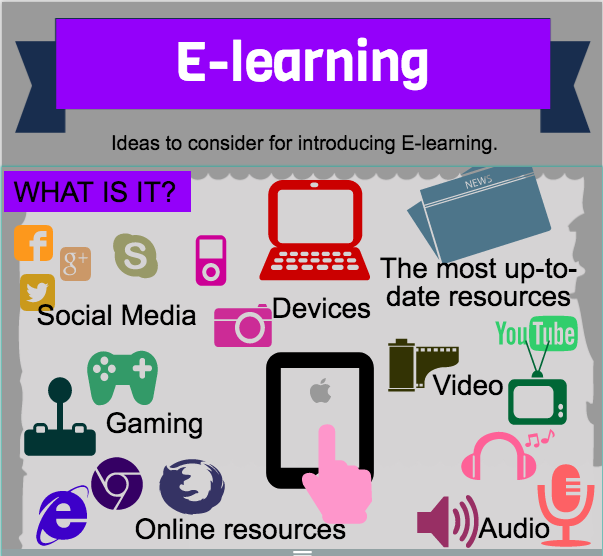|
What is crisis teaching? Crisis teaching involves implementing a rapid change to lesson delivery methods to meet a short-term educational need in a time of crisis. As we head into Week 1 of Term 3, many students and teachers have been in some form of lockdown or isolation for around 4 weeks. The prospect of maintaining quality teaching and learning while looking after our own mental and physical health during the COVID pandemic is a challenge at best. Most schools have had to begin the process of teaching remotely for a fortnight prior to school holidays due to parents choosing to keep students at home. This unprecedented rush for remote learning has meant that schools have had to make decisions about how to quickly flip their teaching instruction to a new format, all at a time when most teachers are stressed and exhausted as a result of what's happening in the community and the world more broadly. As we begin Term 3, we head into a fairly uncertain term with the prospect of a longer period of remote learning. Schools will make decisions about how to deliver remote learning - paper work booklets picked up or posted home, video conferencing sessions, online learning, one on one phone calls, or a combination. At this time it is a good opportunity to review some key principles of E-Learning for those schools who will deliver online learning.. Hints and Tips for Online Learning Design for the long-term – It is likely that we will be teaching online for most of this term. When designing your resources, plan in such a way that you can reuse the items in coming years, rather than just for this experience. Use and reuse existing resources as much as possible. If you choose to prerecord sections of your lessons these could be useful in the long term - if the session provides overviews of concepts, skills or processes then you may choose to use them again, but if the prerecorded session is describing to students what activities you want them to complete, or include information that is specific to particular students or this particular time, then you are unlikely to use them again. Focus on engagement – While it is important to cover course content, ensure that your teaching allows for collaboration, social interaction, group and independent work. In doing so, you may choose to use a variety of technology tools and limit text based presentation/resources to improve engagement by using audio visual enhancement – images, graphics, video production. Overestimate timing – both the time to create online resources and the time for students to complete work online are likely to be longer than you initially anticipate. Be realistic about the time required for students to complete tasks and ensure that your expectations are appropriate and fair. Manage your time (and your students') - Find ways to manage your time effectively. This may include locking out time for online engagement – e.g. timetable, or locking out time for resource development. Use an online calendar as part of your teaching and learning – planning, scheduling posts, etc. If you receive a number of queries from students, consider using public posts to address issues in case other students are also considering asking the same thing. Save time by sharing resources with your colleagues, and using online resources rather than creating everything from scratch - websites, online journals, digital libraries, eBooks. Communicate clearly with students about what is required - Be clear about what work needs to be submitted, when, and how. Provide checklists for students – what is required to be finished each week? Provide overviews of structure and content. While the tone of communication in online platforms needs to be appropriate for teacher student interactions, it should be relatively personal and conversational so that it is easy to understand for students, encourages social interaction and is engaging. Digital organisation - set up systems for file management (both for the faculty/teacher and the students). It will be a lot easier if you can find what you need easily. Set up systems of folders, processes for submission to allow easier online marking. Ensure that you Google Classroom (or any other program) is easy to navigate and that students can easily find resources (e.g. you may choose to use (banners, menus, maps, inventories, clear directions). Learning and support - Provide opportunities for students to practice/rehearse skills, scaffold to support learning and assessment and incorporate peer feedback/assessment and self-assessment to edit. Online Learning Models Models of online or remote learning can provide a cycle or rhythm to follow or just a combination of different types of lesson delivery. Examples include combinations of : - direction instruction - collaborative learning - guided instruction, and - independent learning How does this differ from how you teach online? Do you like the model? what are the advantages and disadvantages of the model? Do you have a rhythm or routine in the way you do your lessons (e.g. one lesson direction instruction, one lesson group work, one lesson research....etc)? How might a model like this assist you when some students are at school and some students are at home?
0 Comments
Video conferencing tools:
Benefits of videoconferencing:
Providers for video conferencing:
Once you have done a few organised sessions and feel comfortable using the technology, you will be able to make connections with people and organise your own presenters. Video Conference lesson Research the work of the organisation or person that will be running the videoconference. Provide a brief summary of the work of the organisation or person. Formulate a number of questions that you can ask to the person during the videoconference. These may relate to the work of your class as a whole or your own geographical inquiry. As a class collect the questions that have been designed and remove any duplicates. It may be beneficial to send the questions to your presenter ahead of the video conference. Linking to other websites
You can provide a link to another website without attribution as the website will have its own logos, copyright information, etc. associated. However, if a website has a document available that you download, you can’t legally upload the document onto your site. You can only link to the document in its existing location. For example you can’t download a HSC exam of syllabus document and upload it onto your site. Youtube and Google Maps Some website creators/blogs allow you to directly embed Youtube clips and Google Maps onto your webpage. When you do this, you are actually providing a link to the Youtube site or Google site and as a result you don’t need to attribute/cite the source. The Youtube or Google logos will show on your website where you have embedded the resource. Youtube has the responsibility to ensure that their users meet copyright regulations. For example if there is a clip of the Sydney Symphony Orchestra playing a piece by Beethoven, it is the responsibility of Youtube to address the copyright issues. If you decided to take a screen shot from a Youtube clip or Google Maps application this would require attribution. Music Music is very difficult to work with in online publishing. Copyright applies to both the performance of music and the written piece of music. In most cases a licence must be paid for use of music online which can be very expensive. A work-around is to embed a Youtube clip of the music being performed to pass on the copyright responsibilities to a third party. Using material from other websites If you want to use material from other websites it is best to just link to the site. However in the case where you just have a small section of text it is fine to just quote the source and provide a link back to the webpage that you found it. In the case of the Board of Studies, they are very touchy about their property being reproduced. If you use a section of the syllabus for example, type NSW Board of Studies beneath the quote and then link from the words “NSW Board of Studies” to the page the information is found. Working with graphics When creating your class website, you need to be very wary that all the images and graphics that you use are copyright clear and don’t breach any privacy policies of the Department of Education. 1. Use photographs that you have taken yourself. Dig out your holiday snaps. Ideally you don’t want to be using photos of yourself, but you can always edit yourself out if necessary. Don’t forget that most phones these days have pretty good camera capabilities. If you are out somewhere and see a great shot that would work well on your website then take it. 2. Don’t publish photos of students. Most students at the school have signed a “Permission to Publish” form, but some have not. This could be for a whole range of reasons such as a witness protection, domestic violence issues, etc. To avoid any problems it is best to avoid photos with students. If you want to use photos of students doing something or making something try to frame the photo so that you just see the student’s hands or the back of their head. Obviously photos of students are posted on the official school websites, but these go through a series of checks to ensure that no-one is published that shouldn’t be. 3. Use image repositories. Sites such as wikicommons, flickr, shutterstock, and getty images allow some of their images to be used in online projects without citing the source (some of these will also require that you pay for them). Others will require that you cite the source correctly. In this case you will need to state the owner/creator as well as the type of license used. See below “Using Wikicommons”. 4. Create your own images. You may choose to create your own diagrams or modify images using programs such as Adobe Photoshop or Adobe Fireworks. This is usually a more complicated option for using graphics, but can be mastered fairly quickly. For further information examine the DEC resource: Copyright for Teachers. What is E-learning? E-learning is supporting learning through electronic (online) material. Students are able to access resources anytime and any place as long as they have access to the internet. E-learning can involve students accessing digital resources in class, just at home, or a combination of both. It can include videos, audio, interactive websites, online forums as well as text and images. It can incorporate mobile devices (phones, ipads, tablets). How could we use E-learning? - Subject – specific resources - Cross-curriculum projects - Welfare/Wellbeing resources - Library resources - Professional Learning for staff - Online courses/information for parents What are the issues related to introducing E-learning? - Staff training - Staff time and enthusiasm - Copyright issues - images, music, video, diagrams, etc - Quality control - Student access - across devices, using DEC internet - Marketing the school - Maintaining a competitive edge (seniors) - some people may be reluctant to share their senior resources. There are a range of options that can be used to introduce E-learning: - Moodle - iPads/Apps - Youtube - Gaming - Edmodo - Weebly/wordpress,etc
This is part two of a series of posts about the BYOD Project.
Teacher Surveys All teachers involved in the BYOD Project participated in BYOD Pre-Project Teacher survey. The key findings were:
Student Focus Groups Engaging with an academic partner during our action research journey enabled us to get guidance and feedback for a research methodology, it also provide insight into emerging research and introduced innovative practice to be implemented in the classroom. Dr Jane Hunter is from UWS, where she works in the areas of curriculum, pedagogy and technology integration in learning. She came to the school on in May to run two focus groups with 8-10 of our boys regarding technology use in the classroom. The sessions were audio-recorded, transcribed and then a report outlining the main themes was written. This provided pre-project data and information to provide direction for the project. Topics discussed include weaknesses and strengths in use of technology for learning currently, the use of technology to assist in: collaboration, creativity, problem solving, critical thinking, etc, the use of technology for sharing work with the outside world/community, differences between the technology skills students use at home and the skills they are “allowed”/expected to use at school, infrastructure/systems issues that make using technology difficult at school, opportunities/possibilities that students see in using technology – ideas, programs, strategies, processes, the value of technology to future employment and student perceptions of staff technology skills as compared to their own. Pre-Project Lesson Collection The last part of the pre-project phase was the collection of a couple of lesson plans outlining ways that technology is currently integrated into lessons. Following the submission of the lesson teachers met to discuss them with reference to some of the research and professional reading we had been looking at. A few samples of lesson plan proformas from the University of Sydney were emailed to teachers to use to write lesson plans. Over the next year or so the Middle School Team at Epping Boys High School will be undertaking action research on the implementation of BYOD and teacher capacity to implement it effectively. It will be run with a small group of volunteer teachers with strategies implemented in some of their classes.
This Action Research Project aims to investigate the factors influencing the implementation of the BYOD program at Epping Boys High. It will examine the extent to which students are currently engaging with the program and students’ attitudes to BYOD. Teachers’ perceptions of the program will also be examined in addition to teachers’ technology capabilities and the pedagogical frameworks underpinning the integration of technology in the classroom. The aims of the project are to develop teacher capabilities in integrating technology in teaching practice with an emphasis on more collaborative, creative and productive uses of technology to enhance student learning. Teachers involved in the project will receive ongoing professional development and support. The project will involve ongoing documentation and mapping against the Australian Professional Standards to assist teachers in the accreditation process. Project Plan The project will be developed in three main phases: pre-project, project, and post-project. Pre-project Phase – collection of baseline data Before the commencement of the project baseline data will be collected including student and staff surveys and BYOD usage statistics. In this phase teachers involved will be asked to submit 2-3 lesson plans explaining how they have used the BYO Devices in the previous month or so. Student focus groups will be run. Project phase – implementation of professional learning and new skills Staff will undertake a range of professional learning experiences and collaboratively develop ideas and plans for integrating new technology skills into their teaching practice. The lesson ideas will be implemented across a number of classes across Years 7-9. Teachers will meet to reflect on their experiences and review their lesson ideas. Teachers will be asked to submit a further 2-3 lesson plans. Teachers may choose to observe each others’ lessons or team-teach to explore levels of student engagement. Post-project Phase – evaluation of project The post-project phase involves re-surveying of students and staff, collection of BYOD usage statistics, and collaborative assessment of lesson plans and reflection on the successes and failures of the project. This phase may bring to light further areas for development in future projects or initiatives. Relevant Research Some suggestions: Bloom's Digital Taxonomy High Possibility Classrooms: a new model of technology integration for schools Technological Pedagogical Content Knowledge: A Framework for Teacher Knowledge Mobile Technologies and Learning literature review http://acec2014.acce.edu.au/sites/2014/files/ACEC2014%20Conference%20Proceedings%20Last.pdf http://www.futurelab.org.uk/resources |
Categories
All
Archives
May 2024
|



